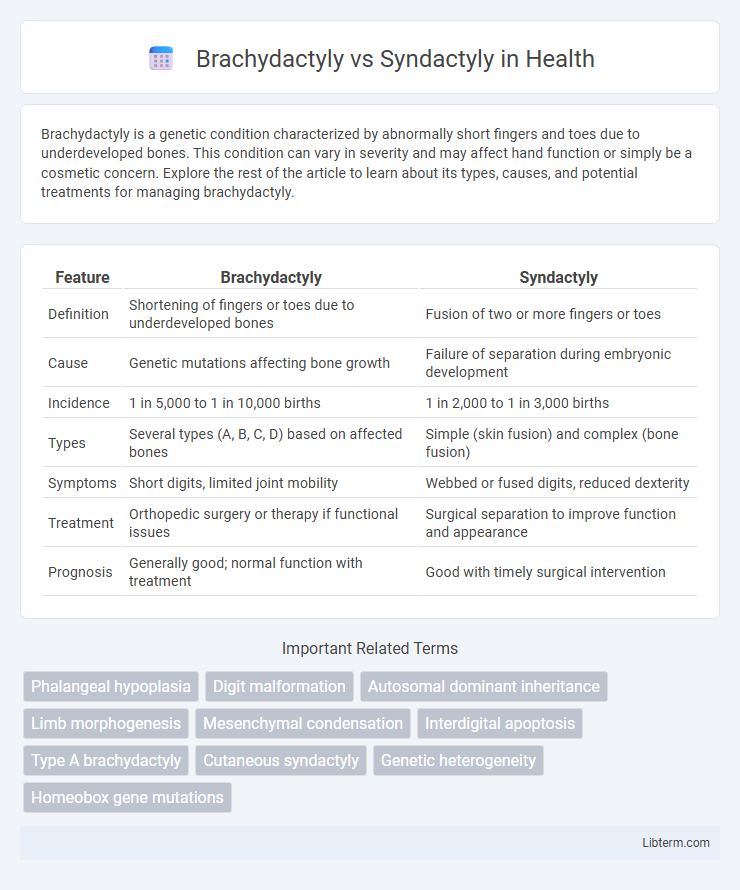Brachydactyly is a genetic condition characterized by abnormally short fingers and toes due to underdeveloped bones. This condition can vary in severity and may affect hand function or simply be a cosmetic concern. Explore the rest of the article to learn about its types, causes, and potential treatments for managing brachydactyly.
Table of Comparison
| Feature | Brachydactyly | Syndactyly |
|---|---|---|
| Definition | Shortening of fingers or toes due to underdeveloped bones | Fusion of two or more fingers or toes |
| Cause | Genetic mutations affecting bone growth | Failure of separation during embryonic development |
| Incidence | 1 in 5,000 to 1 in 10,000 births | 1 in 2,000 to 1 in 3,000 births |
| Types | Several types (A, B, C, D) based on affected bones | Simple (skin fusion) and complex (bone fusion) |
| Symptoms | Short digits, limited joint mobility | Webbed or fused digits, reduced dexterity |
| Treatment | Orthopedic surgery or therapy if functional issues | Surgical separation to improve function and appearance |
| Prognosis | Generally good; normal function with treatment | Good with timely surgical intervention |
Introduction to Brachydactyly and Syndactyly
Brachydactyly is a congenital condition characterized by abnormally short fingers or toes resulting from underdeveloped or missing bones in the digits. Syndactyly involves the fusion or webbing of two or more fingers or toes, causing partial or complete joining of the digits. Both conditions arise from genetic mutations affecting limb development during embryogenesis and vary widely in severity and clinical presentation.
Defining Brachydactyly: Causes and Features
Brachydactyly is a genetic condition characterized by unusually short fingers and toes due to underdeveloped or absent bones, primarily affecting the phalanges or metacarpals. Caused by mutations in genes such as HOXD13, it results in varied types ranging from isolated digit shortening to complex syndromic presentations. Key features include shortened digits with normal joint function, distinguishing it from syndactyly, which involves fused or webbed fingers and toes.
Understanding Syndactyly: Causes and Features
Syndactyly, characterized by the fusion of two or more fingers or toes, results from genetic mutations or disruptions during embryonic development, often linked to mutations in the HOXD13 gene. This congenital condition presents in various forms, including simple syndactyly where soft tissue is fused and complex syndactyly involving bone fusion. Syndactyly's incidence varies globally, with a prevalence of about 1 in 2,000 to 2,500 live births, and it can occur as an isolated anomaly or as part of genetic syndromes such as Apert syndrome.
Genetic Factors in Brachydactyly and Syndactyly
Brachydactyly is primarily caused by mutations in genes such as HOXD13 and GDF5, which affect bone growth and development, leading to shortened digits. Syndactyly often results from genetic variants in the HOXD13 gene or disruptions in the SHH (Sonic Hedgehog) signaling pathway, causing abnormal fusion of fingers or toes. Both conditions exhibit autosomal dominant inheritance patterns but involve distinct genetic mechanisms influencing digit formation.
Clinical Presentation: Key Differences
Brachydactyly presents as abnormally short fingers or toes due to shortened bones, often affecting the middle or proximal phalanges and resulting in a noticeable reduction in digit length. Syndactyly is characterized by the fusion of two or more fingers or toes, either through soft tissue or bone, leading to webbed or conjoined digits that impair individual finger movement. Clinically, brachydactyly primarily affects digit length and dexterity, whereas syndactyly impacts digit separation and functional grasp.
Diagnostic Methods for Brachydactyly vs Syndactyly
Diagnostic methods for brachydactyly primarily involve clinical examination to identify shortened digits, supported by radiographic imaging to assess bone abnormalities and confirm the extent of phalangeal shortening. Syndactyly diagnosis relies on physical assessment to detect fused digits, with imaging techniques such as X-rays or MRI used to evaluate soft tissue and bone fusion patterns. Genetic testing can assist in both conditions by identifying specific gene mutations linked to inherited forms of brachydactyly and syndactyly, providing clarity in complex cases.
Treatment Options: Brachydactyly vs Syndactyly
Treatment options for brachydactyly primarily involve surgical lengthening or corrective osteotomy to improve finger function and appearance, often combined with physical therapy. Syndactyly treatment typically requires surgical separation of fused digits, followed by skin grafting and rehabilitative therapy to enhance mobility and dexterity. Early intervention in both conditions improves functional outcomes and reduces complications related to joint stiffness or deformity.
Prognosis and Complications
Brachydactyly typically presents a favorable prognosis with minimal functional impairment and rare complications, as it primarily involves shortened digits without fusion. Syndactyly carries a variable prognosis depending on the severity of finger fusion and requires surgical intervention to prevent functional limitations, joint stiffness, and growth abnormalities. Early diagnosis and treatment in syndactyly reduce risks of compromised hand dexterity and long-term deformities.
Living with Brachydactyly or Syndactyly
Living with brachydactyly or syndactyly often requires adapting daily activities to accommodate shortened or fused fingers, impacting fine motor skills and grip strength. Customized occupational therapy and ergonomic tools can enhance hand function and independence for individuals with these congenital conditions. Psychological support and community resources further improve quality of life by addressing social and emotional challenges associated with visible hand differences.
Future Research and Advances
Future research on brachydactyly and syndactyly aims to enhance genetic understanding through advanced genome sequencing and CRISPR-based gene editing techniques to identify precise mutations and potential therapeutic targets. Emerging studies leverage 3D bioprinting and stem cell technologies to develop regenerative treatments and improve surgical outcomes for digit reconstruction. Innovations in bioinformatics and machine learning facilitate personalized medicine approaches, enabling early diagnosis and tailored interventions for these congenital hand anomalies.
Brachydactyly Infographic

 libterm.com
libterm.com